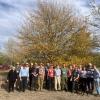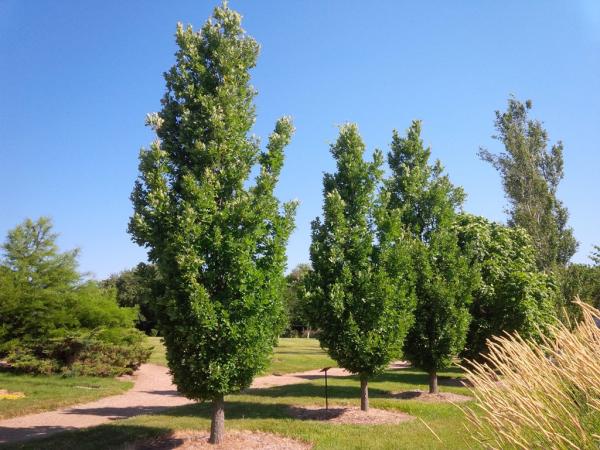Editor's Picks
Plant Focus
Sir Arthur Tansley, the “Father of British Ecology”, appears to have been exasperated by oaks in Scotland. He wrote of pedunculate (Quercus robur) and sessile (Q. petraea) oaks that: “In Scotland particularly there is a great mixture of forms, so that in many woods it is difficult to find a typical tree of either species…” (Tansley 1949). He went on to suggest that this was probably the result of extensive 18th and 19th century planting and subsequent hybridization events. His opinions have been echoed down the years by many British foresters.

In the 1960s J.E. Cousens of the University of Edinburgh set out to investigate this matter. He found that: “If they [Q. robur and Q. petraea] are acceptable taxa then these data show that the proportion of hybrids in Scotland is at least 50 % and probably 75 %.” He concluded that: “Striking variation patterns are found in Scottish oakwoods but practically all the variation can be completely accounted for by postulating (a) limited interspecific hybridization and (b) extensive introgression initiated or accelerated by Man's planting activities” (Cousens 1963). After a more detailed investigation, he came to the conclusion that: “Introgression of both species increases northwards into Scotland, where the greater introgression of Q. petraea has been made possible by the planting of Q. robur to maintain the stocking of Q. petraea coppice” (Cousens 1965). But see my reservation about this below.
We might have regarded the issue as resolved: sessile oak was the original Scottish native, but extensive planting of pedunculate oak, perhaps because of a belief that its timber was superior, resulted in gene flow between the two species and a bit of a genetic mess.

However, in 2003 a group of French researchers published a paper that would tell a different story about the relationship between these two oak species (Petit et al. 2003). It has long been known that pedunculate oak is a better colonizer of open ground than its syngameon partner, aided by jays’ habit of caching acorns. It also grows faster at first when light is not a limiting factor and so will establish more readily in the open than Q. petraea.
Rémy Petit and his colleagues argued that Q. robur would have been a more opportunistic colonizer than Q. petraea and would have been the pioneer species as ice retreated at the end of the last glacial episode. These early forests of pedunculate oak were then infiltrated by sessile oak through a mechanism they refer to as pollen swamping. Limited hybridization events would have been followed by back-crossing, with natural selection favoring the more shade-bearing late successional Q. petraea. Thus an initial pedunculate oak population would be invaded by sessile oak genes in the course of several generations. A Q. petraea phenotype would emerge in the denser center of this new forest, with Q. robur at its edges. This process would continue as the ice retreated, with long distance dispersal of pedunculate oak seed followed by interspecific pollen flow.

That is an intriguing proposition, summarized in the title of the 2003 paper: “Hybridization as a mechanism of invasion in oaks”. The two oaks have a sympatric range in Britain, extending to the north of the Scottish mainland. Could we be witnessing a stage in that process of invasion, as sessile oak continues to invade a pioneer pedunculate oak population in Scotland? There is just one problem with that scenario: it’s the precise opposite of the Cousens hypothesis, which saw a sessile oak population being invaded by pedunculate oak genes.
The Cousens study was much-cited and respected but it was limited to a morphological analysis. As far as I have been able to ascertain, it has never been followed up with any molecular studies, and it pre-dated the current appreciation of the mechanisms of gene flow, and the concept of the ecological species (Van Valen 1976). I am skeptical about one aspect of his argument and that of Tansley and others (with all due respect): the emphasis on the role of planting in introgression.
Woodland planting in Britain was virtually unknown before about 1600 so at most there can have been eight generations—probably far fewer—separating the current situation from any initial human intervention. That strikes me as far too few to account for the degree of introgression we see in Scotland. If I am right, the question remains open: is pedunculate oak invading sessile oak populations or is it the other way around, and what can account for it? Please, someone, do the research!
Works cited
Tansley, A.G. 1949. Britain’s Green Mantle. London: George Allen & Unwin Ltd.
Cousens, J.E. 1963. Variation of some diagnostic characters of the sessile and pedunculate oaks and their hybrids in Scotland. Watsonia 5: 273-86.
Cousens, J.E. 1965. The status of the pedunculate and sessile oaks in Britain. Watsonia 6:161-76.
Petit, R.J., C. Bodénès, A. Ducousso, G. Roussel, and A. Kremer. 2003. Hybridization as a mechanism of invasion in oaks. New Phytologist 161:151-64.
Van Valen, L.1976. Ecological Species, Multispecies, and Oaks. Taxon 25: 233-39.















